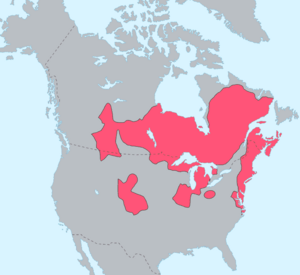Algonquian languages facts for kids
The Algonquian languages are a group of Native American languages. They are spoken by many different Indigenous peoples across North America. These languages are part of a larger language family called Algic. The word "Algonquin" comes from the Maliseet word elakómkwik. This means "they are our relatives" or "allies."
Sadly, many Algonquian languages are now in danger of disappearing. Some have already been lost completely.
Contents
What are Algonquian Languages?
Algonquian languages are a "subfamily" of languages. This means they are a smaller group within a much larger "language family." Think of it like branches on a tree. All these languages grew from one older language. This original language was spoken at least 3,000 years ago!
There are many different Algonquian languages. Some well-known ones include Cree, Ojibwe, Blackfoot, and Cheyenne. Each language has its own unique sounds, words, and grammar rules.
Where are They Spoken?
Speakers of Algonquian languages live across a huge area. Their lands stretch from the east coast of North America. They go all the way to the Rocky Mountains in the west. This includes parts of what is now Canada and the United States.
Historically, Algonquian peoples lived in diverse environments. They lived in forests, on plains, and near the Great Lakes. This wide spread shows how successful and adaptable these groups were.
Why are These Languages Important?
Algonquian languages are more than just words. They carry the history, culture, and wisdom of Indigenous peoples. Each language holds unique stories, traditions, and ways of understanding the world.
- They help connect people to their ancestors.
- They preserve traditional knowledge about nature and life.
- They are a key part of cultural identity for many communities.
Saving These Languages
Many Algonquian languages are endangered today. This means fewer and fewer people speak them. When a language is lost, a whole way of seeing the world can be lost too.
However, many Indigenous communities are working hard to save their languages. They are creating language programs for children. They are also teaching adults. These efforts help to keep these important languages alive for future generations.
See also
 In Spanish: Lenguas algonquinas para niños
In Spanish: Lenguas algonquinas para niños


